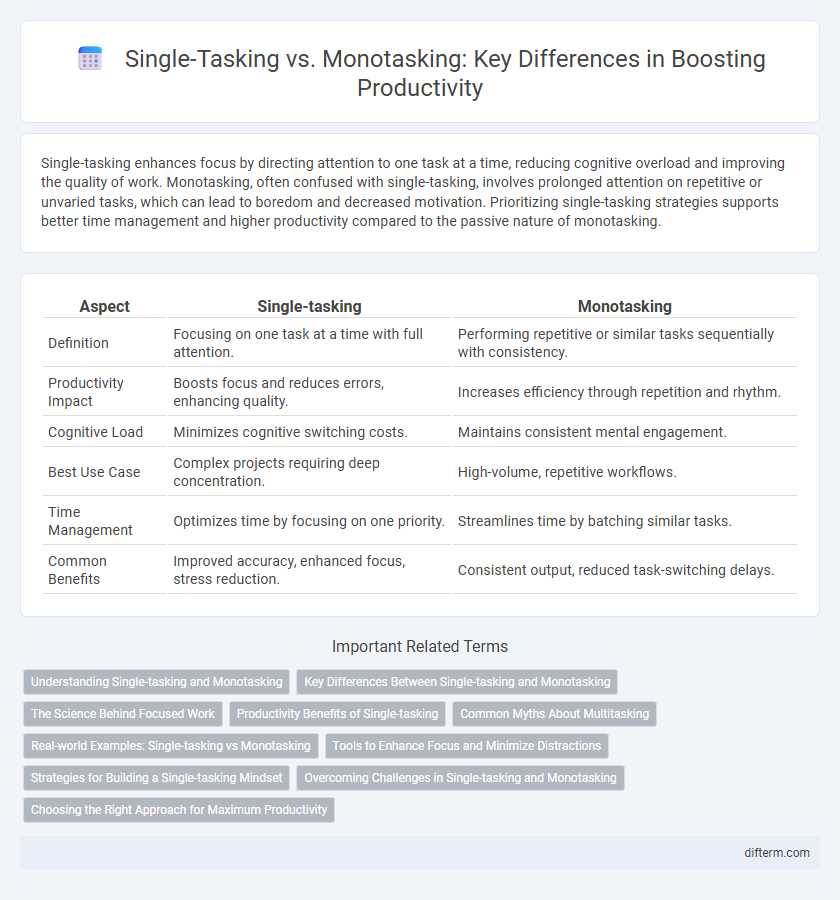Single-tasking enhances focus by directing attention to one task at a time, reducing cognitive overload and improving the quality of work. Monotasking, often confused with single-tasking, involves prolonged attention on repetitive or unvaried tasks, which can lead to boredom and decreased motivation. Prioritizing single-tasking strategies supports better time management and higher productivity compared to the passive nature of monotasking.
Table of Comparison
| Aspect | Single-tasking | Monotasking |
|---|---|---|
| Definition | Focusing on one task at a time with full attention. | Performing repetitive or similar tasks sequentially with consistency. |
| Productivity Impact | Boosts focus and reduces errors, enhancing quality. | Increases efficiency through repetition and rhythm. |
| Cognitive Load | Minimizes cognitive switching costs. | Maintains consistent mental engagement. |
| Best Use Case | Complex projects requiring deep concentration. | High-volume, repetitive workflows. |
| Time Management | Optimizes time by focusing on one priority. | Streamlines time by batching similar tasks. |
| Common Benefits | Improved accuracy, enhanced focus, stress reduction. | Consistent output, reduced task-switching delays. |
Understanding Single-tasking and Monotasking
Single-tasking involves focusing on one task at a time to enhance concentration and reduce errors, while monotasking emphasizes performing a repetitive activity with minimal cognitive load. Both strategies help minimize distractions and improve task efficiency by promoting sustained attention on a singular objective. Understanding these approaches allows individuals to choose the best method for optimizing productivity based on task complexity and personal work style.
Key Differences Between Single-tasking and Monotasking
Single-tasking involves focusing on one task at a time with full attention, minimizing distractions to enhance accuracy and efficiency. Monotasking emphasizes repetitive engagement with the same task, often involving routine or automated processes that require less cognitive effort. The key difference lies in single-tasking's active concentration versus monotasking's repetitive nature, affecting productivity based on task complexity and mental demand.
The Science Behind Focused Work
Focused work activates the brain's prefrontal cortex, enhancing cognitive control and reducing distractions, which improves productivity and task accuracy. Single-tasking, also known as monotasking, leverages this neurological mechanism by allowing sustained attention on one activity, minimizing cognitive switching costs that impair efficiency. Neuroscientific studies reveal that multitasking increases mental fatigue and decreases overall performance, while monotasking facilitates deeper concentration and better memory retention.
Productivity Benefits of Single-tasking
Single-tasking enhances productivity by allowing the brain to focus entirely on one task, reducing cognitive overload and minimizing errors. Research shows that concentrating on a single activity increases work quality and efficiency, leading to faster completion times compared to multitasking or monotasking. Tools like time-blocking and distraction-free environments further amplify the productivity benefits of single-tasking, promoting sustained attention and deeper engagement.
Common Myths About Multitasking
Multitasking often decreases productivity as the brain switches focus between tasks, leading to cognitive fatigue and diminished performance. Common myths suggest multitasking saves time, but studies show single-tasking or monotasking improves concentration and task efficiency by reducing errors and mental strain. Embracing monotasking enhances workflow by allowing deeper engagement with one activity, ultimately boosting overall productivity and task completion quality.
Real-world Examples: Single-tasking vs Monotasking
Single-tasking involves focusing on one task at a time to maximize efficiency, exemplified by writers dedicating uninterrupted hours to drafting a manuscript. Monotasking refers to performing repetitive or similar tasks that require minimal cognitive shifting, such as an assembly line worker assembling identical components continuously. Real-world productivity improvements are evident when professionals like software developers opt for single-tasking during coding sessions, reducing errors and enhancing concentration compared to multitasking environments.
Tools to Enhance Focus and Minimize Distractions
Single-tasking tools such as Focus@Will and Cold Turkey block distractions by creating controlled environments that optimize concentration through music and website restrictions. Monotasking apps like Forest and Tide help users cultivate sustained attention by encouraging timed work sessions paired with visual or auditory cues that reinforce productivity. Integrating these tools with techniques like the Pomodoro method significantly reduces cognitive overload and improves task completion rates.
Strategies for Building a Single-tasking Mindset
Fostering a single-tasking mindset involves prioritizing one task at a time to enhance focus and efficiency, minimizing distractions by setting clear boundaries such as designated work periods and digital detoxes. Techniques like time blocking, where specific intervals are reserved for individual tasks, and mindfulness practices help improve concentration and reduce cognitive overload. Regularly reviewing and adjusting task priorities ensures sustained commitment to single-tasking strategies, leading to improved productivity and quality of work.
Overcoming Challenges in Single-tasking and Monotasking
Overcoming challenges in single-tasking and monotasking requires cultivating strong focus and minimizing distractions through techniques such as time blocking and environment optimization. Implementing structured breaks and mindfulness practices helps maintain sustained attention and prevents cognitive fatigue. Leveraging productivity tools that limit multitasking enhances task completion efficiency and improves overall work quality.
Choosing the Right Approach for Maximum Productivity
Single-tasking, the practice of focusing on one task at a time, enhances concentration and reduces errors, making it ideal for complex or detail-oriented projects. Monotasking, often used interchangeably but subtly different, emphasizes sustained focus on a single task without interruptions, boosting deep work and flow states. Selecting the right approach depends on task complexity, individual work habits, and the need for cognitive resources to maximize productivity and minimize burnout.
Single-tasking vs Monotasking Infographic

 difterm.com
difterm.com